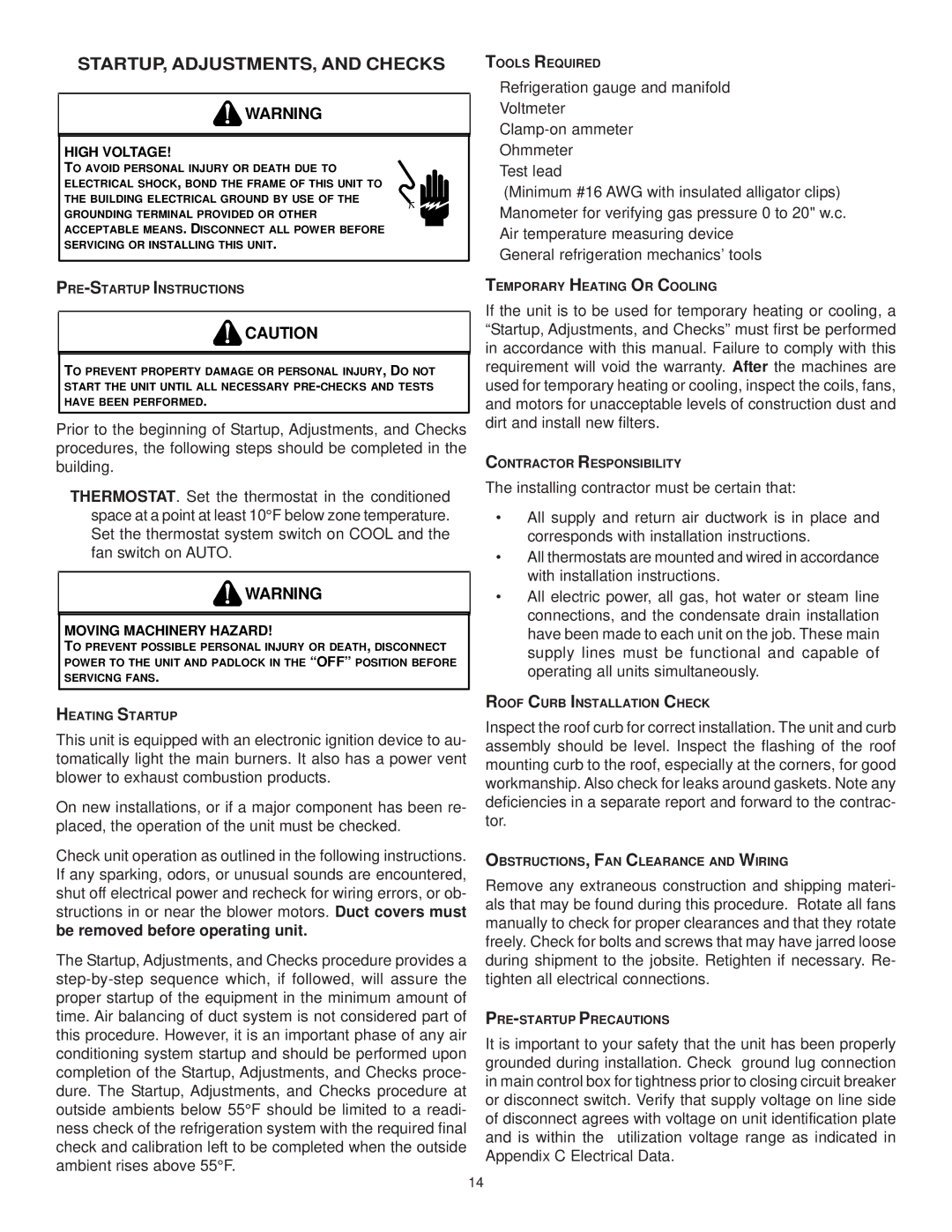
STARTUP, ADJUSTMENTS, AND CHECKS
![]() WARNING
WARNING
HIGH VOLTAGE!
TO AVOID PERSONAL INJURY OR DEATH DUE TO ELECTRICAL SHOCK, BOND THE FRAME OF THIS UNIT TO THE BUILDING ELECTRICAL GROUND BY USE OF THE GROUNDING TERMINAL PROVIDED OR OTHER ACCEPTABLE MEANS. DISCONNECT ALL POWER BEFORE SERVICING OR INSTALLING THIS UNIT.
PRE-STARTUP INSTRUCTIONS
![]() CAUTION
CAUTION
TO PREVENT PROPERTY DAMAGE OR PERSONAL INJURY, DO NOT START THE UNIT UNTIL ALL NECESSARY
Prior to the beginning of Startup, Adjustments, and Checks procedures, the following steps should be completed in the building.
THERMOSTAT. Set the thermostat in the conditioned space at a point at least 10°F below zone temperature. Set the thermostat system switch on COOL and the fan switch on AUTO.
![]() WARNING
WARNING
MOVING MACHINERY HAZARD!
TO PREVENT POSSIBLE PERSONAL INJURY OR DEATH, DISCONNECT POWER TO THE UNIT AND PADLOCK IN THE “OFF” POSITION BEFORE
SERVICNG FANS.
HEATING STARTUP
This unit is equipped with an electronic ignition device to au- tomatically light the main burners. It also has a power vent blower to exhaust combustion products.
On new installations, or if a major component has been re- placed, the operation of the unit must be checked.
Check unit operation as outlined in the following instructions. If any sparking, odors, or unusual sounds are encountered, shut off electrical power and recheck for wiring errors, or ob- structions in or near the blower motors. Duct covers must be removed before operating unit.
The Startup, Adjustments, and Checks procedure provides a
TOOLS REQUIRED
Refrigeration gauge and manifold Voltmeter
Test lead
(Minimum #16 AWG with insulated alligator clips) Manometer for verifying gas pressure 0 to 20" w.c. Air temperature measuring device
General refrigeration mechanics’ tools
TEMPORARY HEATING OR COOLING
If the unit is to be used for temporary heating or cooling, a “Startup, Adjustments, and Checks” must first be performed in accordance with this manual. Failure to comply with this requirement will void the warranty. After the machines are used for temporary heating or cooling, inspect the coils, fans, and motors for unacceptable levels of construction dust and dirt and install new filters.
CONTRACTOR RESPONSIBILITY
The installing contractor must be certain that:
•All supply and return air ductwork is in place and corresponds with installation instructions.
•All thermostats are mounted and wired in accordance with installation instructions.
•All electric power, all gas, hot water or steam line connections, and the condensate drain installation have been made to each unit on the job. These main supply lines must be functional and capable of operating all units simultaneously.
ROOF CURB INSTALLATION CHECK
Inspect the roof curb for correct installation. The unit and curb assembly should be level. Inspect the flashing of the roof mounting curb to the roof, especially at the corners, for good workmanship. Also check for leaks around gaskets. Note any deficiencies in a separate report and forward to the contrac- tor.
OBSTRUCTIONS, FAN CLEARANCE AND WIRING
Remove any extraneous construction and shipping materi- als that may be found during this procedure. Rotate all fans manually to check for proper clearances and that they rotate freely. Check for bolts and screws that may have jarred loose during shipment to the jobsite. Retighten if necessary. Re- tighten all electrical connections.
It is important to your safety that the unit has been properly grounded during installation. Check ground lug connection in main control box for tightness prior to closing circuit breaker or disconnect switch. Verify that supply voltage on line side of disconnect agrees with voltage on unit identification plate and is within the utilization voltage range as indicated in Appendix C Electrical Data.
14
